Nursing Case Study: Analyzing a Deteriorating Patient's Condition
VerifiedAdded on 2021/02/21
|7
|1488
|56
Case Study
AI Summary
This case study analyzes the condition of Mr. Orkins, an 84-year-old patient with Type 2 Diabetes, hypertension, and hyperlipidemia, who experienced a decline in health. The assignment covers the importance of effective care for deteriorating patients. It details the use of primary, secondary, and focused assessments, including the ABC approach and assessments of disability, to identify and address Mr. Orkins's condition. The nurse implemented interventions such as monitoring vital signs, managing medication, ensuring oxygen saturation, and evaluating diet and mobility to address the patient's unconsciousness and potential for stroke. The case also emphasizes the need for culturally safe practices and the role of nursing interventions in improving patient outcomes. The conclusion highlights the importance of these assessments and interventions in managing elderly patients with these conditions.
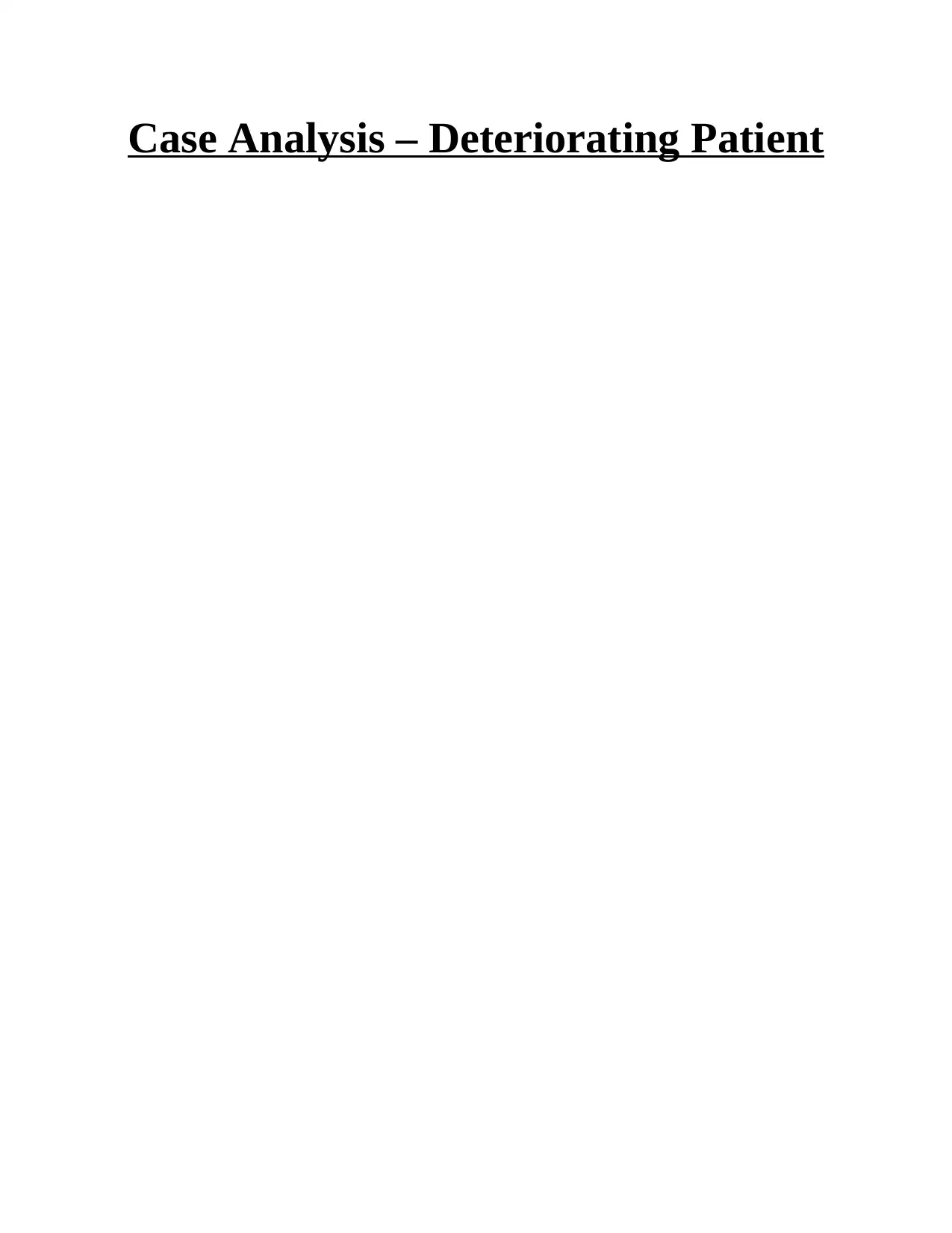
Case Analysis – Deteriorating Patient
Paraphrase This Document
Need a fresh take? Get an instant paraphrase of this document with our AI Paraphraser
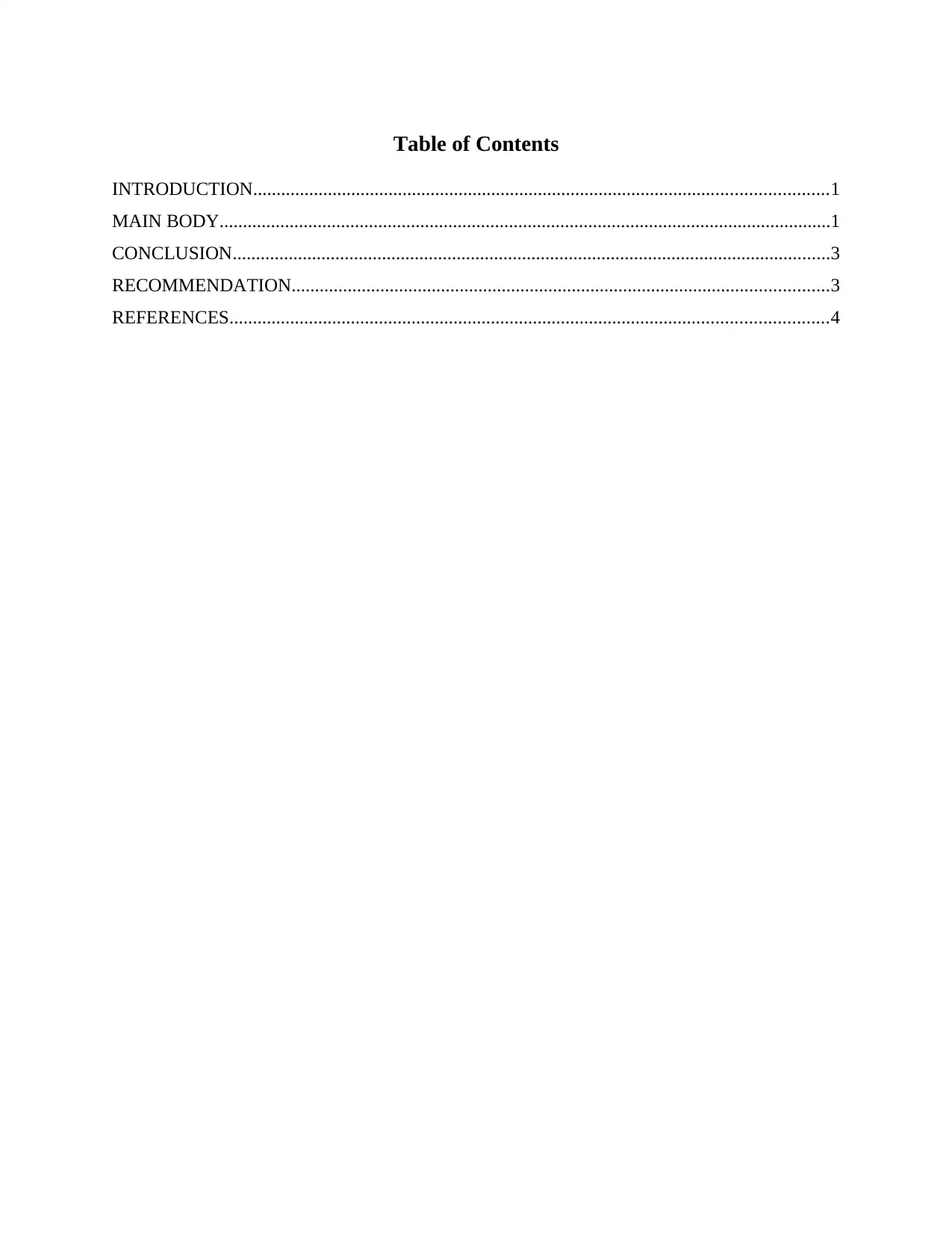
Table of Contents
INTRODUCTION...........................................................................................................................1
MAIN BODY...................................................................................................................................1
CONCLUSION................................................................................................................................3
RECOMMENDATION...................................................................................................................3
REFERENCES................................................................................................................................4
INTRODUCTION...........................................................................................................................1
MAIN BODY...................................................................................................................................1
CONCLUSION................................................................................................................................3
RECOMMENDATION...................................................................................................................3
REFERENCES................................................................................................................................4
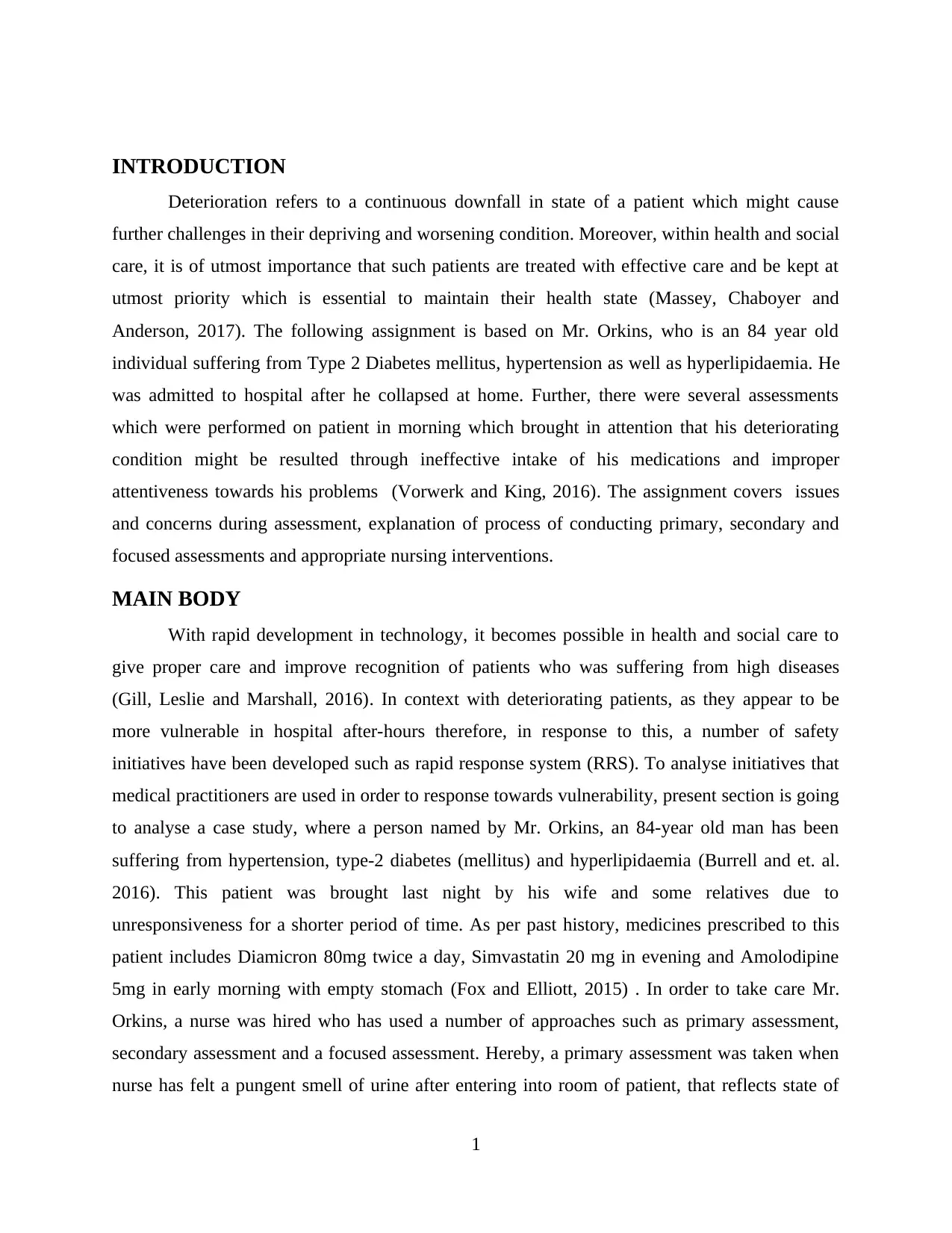
INTRODUCTION
Deterioration refers to a continuous downfall in state of a patient which might cause
further challenges in their depriving and worsening condition. Moreover, within health and social
care, it is of utmost importance that such patients are treated with effective care and be kept at
utmost priority which is essential to maintain their health state (Massey, Chaboyer and
Anderson, 2017). The following assignment is based on Mr. Orkins, who is an 84 year old
individual suffering from Type 2 Diabetes mellitus, hypertension as well as hyperlipidaemia. He
was admitted to hospital after he collapsed at home. Further, there were several assessments
which were performed on patient in morning which brought in attention that his deteriorating
condition might be resulted through ineffective intake of his medications and improper
attentiveness towards his problems (Vorwerk and King, 2016). The assignment covers issues
and concerns during assessment, explanation of process of conducting primary, secondary and
focused assessments and appropriate nursing interventions.
MAIN BODY
With rapid development in technology, it becomes possible in health and social care to
give proper care and improve recognition of patients who was suffering from high diseases
(Gill, Leslie and Marshall, 2016). In context with deteriorating patients, as they appear to be
more vulnerable in hospital after-hours therefore, in response to this, a number of safety
initiatives have been developed such as rapid response system (RRS). To analyse initiatives that
medical practitioners are used in order to response towards vulnerability, present section is going
to analyse a case study, where a person named by Mr. Orkins, an 84-year old man has been
suffering from hypertension, type-2 diabetes (mellitus) and hyperlipidaemia (Burrell and et. al.
2016). This patient was brought last night by his wife and some relatives due to
unresponsiveness for a shorter period of time. As per past history, medicines prescribed to this
patient includes Diamicron 80mg twice a day, Simvastatin 20 mg in evening and Amolodipine
5mg in early morning with empty stomach (Fox and Elliott, 2015) . In order to take care Mr.
Orkins, a nurse was hired who has used a number of approaches such as primary assessment,
secondary assessment and a focused assessment. Hereby, a primary assessment was taken when
nurse has felt a pungent smell of urine after entering into room of patient, that reflects state of
1
Deterioration refers to a continuous downfall in state of a patient which might cause
further challenges in their depriving and worsening condition. Moreover, within health and social
care, it is of utmost importance that such patients are treated with effective care and be kept at
utmost priority which is essential to maintain their health state (Massey, Chaboyer and
Anderson, 2017). The following assignment is based on Mr. Orkins, who is an 84 year old
individual suffering from Type 2 Diabetes mellitus, hypertension as well as hyperlipidaemia. He
was admitted to hospital after he collapsed at home. Further, there were several assessments
which were performed on patient in morning which brought in attention that his deteriorating
condition might be resulted through ineffective intake of his medications and improper
attentiveness towards his problems (Vorwerk and King, 2016). The assignment covers issues
and concerns during assessment, explanation of process of conducting primary, secondary and
focused assessments and appropriate nursing interventions.
MAIN BODY
With rapid development in technology, it becomes possible in health and social care to
give proper care and improve recognition of patients who was suffering from high diseases
(Gill, Leslie and Marshall, 2016). In context with deteriorating patients, as they appear to be
more vulnerable in hospital after-hours therefore, in response to this, a number of safety
initiatives have been developed such as rapid response system (RRS). To analyse initiatives that
medical practitioners are used in order to response towards vulnerability, present section is going
to analyse a case study, where a person named by Mr. Orkins, an 84-year old man has been
suffering from hypertension, type-2 diabetes (mellitus) and hyperlipidaemia (Burrell and et. al.
2016). This patient was brought last night by his wife and some relatives due to
unresponsiveness for a shorter period of time. As per past history, medicines prescribed to this
patient includes Diamicron 80mg twice a day, Simvastatin 20 mg in evening and Amolodipine
5mg in early morning with empty stomach (Fox and Elliott, 2015) . In order to take care Mr.
Orkins, a nurse was hired who has used a number of approaches such as primary assessment,
secondary assessment and a focused assessment. Hereby, a primary assessment was taken when
nurse has felt a pungent smell of urine after entering into room of patient, that reflects state of
1
⊘ This is a preview!⊘
Do you want full access?
Subscribe today to unlock all pages.

Trusted by 1+ million students worldwide
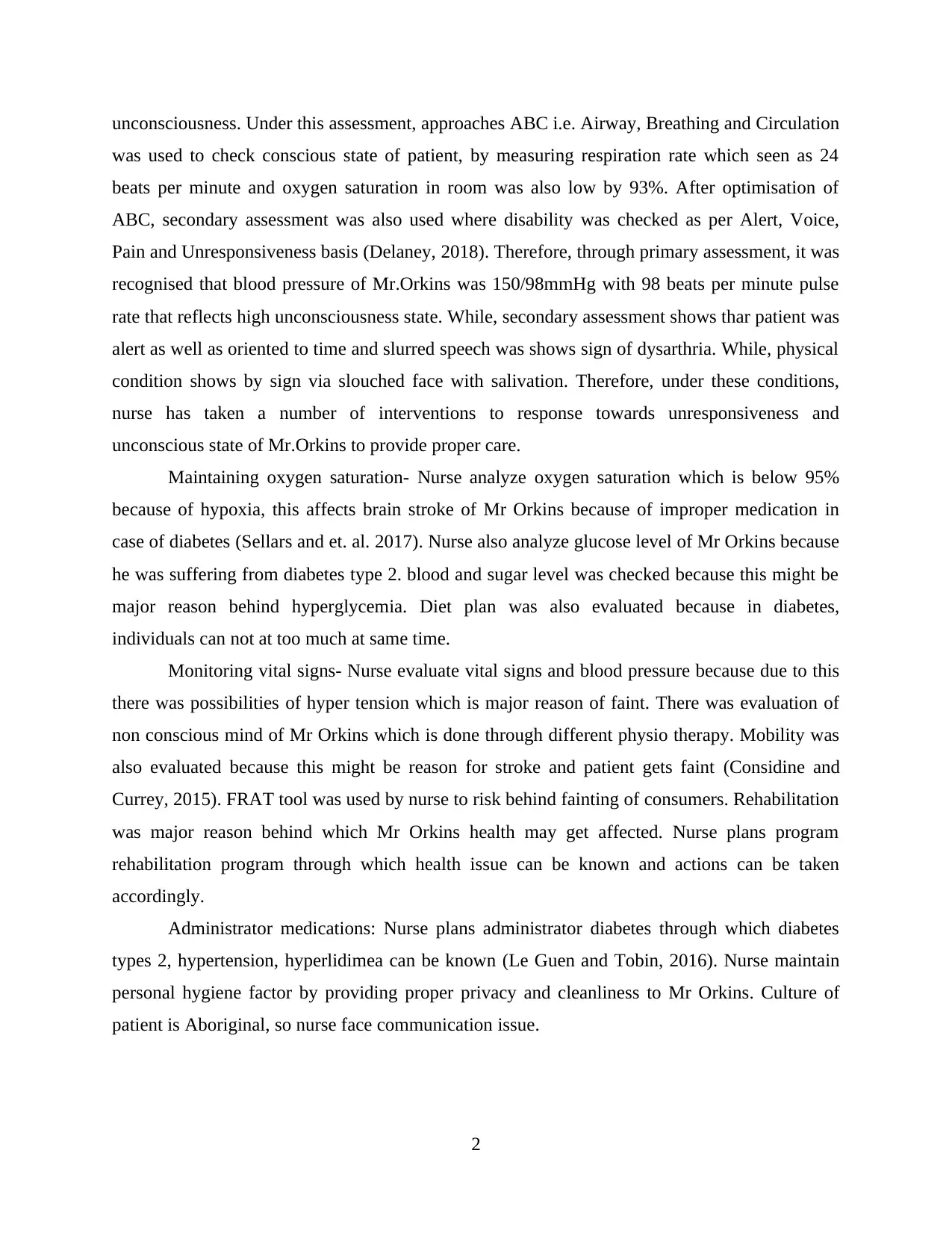
unconsciousness. Under this assessment, approaches ABC i.e. Airway, Breathing and Circulation
was used to check conscious state of patient, by measuring respiration rate which seen as 24
beats per minute and oxygen saturation in room was also low by 93%. After optimisation of
ABC, secondary assessment was also used where disability was checked as per Alert, Voice,
Pain and Unresponsiveness basis (Delaney, 2018). Therefore, through primary assessment, it was
recognised that blood pressure of Mr.Orkins was 150/98mmHg with 98 beats per minute pulse
rate that reflects high unconsciousness state. While, secondary assessment shows thar patient was
alert as well as oriented to time and slurred speech was shows sign of dysarthria. While, physical
condition shows by sign via slouched face with salivation. Therefore, under these conditions,
nurse has taken a number of interventions to response towards unresponsiveness and
unconscious state of Mr.Orkins to provide proper care.
Maintaining oxygen saturation- Nurse analyze oxygen saturation which is below 95%
because of hypoxia, this affects brain stroke of Mr Orkins because of improper medication in
case of diabetes (Sellars and et. al. 2017). Nurse also analyze glucose level of Mr Orkins because
he was suffering from diabetes type 2. blood and sugar level was checked because this might be
major reason behind hyperglycemia. Diet plan was also evaluated because in diabetes,
individuals can not at too much at same time.
Monitoring vital signs- Nurse evaluate vital signs and blood pressure because due to this
there was possibilities of hyper tension which is major reason of faint. There was evaluation of
non conscious mind of Mr Orkins which is done through different physio therapy. Mobility was
also evaluated because this might be reason for stroke and patient gets faint (Considine and
Currey, 2015). FRAT tool was used by nurse to risk behind fainting of consumers. Rehabilitation
was major reason behind which Mr Orkins health may get affected. Nurse plans program
rehabilitation program through which health issue can be known and actions can be taken
accordingly.
Administrator medications: Nurse plans administrator diabetes through which diabetes
types 2, hypertension, hyperlidimea can be known (Le Guen and Tobin, 2016). Nurse maintain
personal hygiene factor by providing proper privacy and cleanliness to Mr Orkins. Culture of
patient is Aboriginal, so nurse face communication issue.
2
was used to check conscious state of patient, by measuring respiration rate which seen as 24
beats per minute and oxygen saturation in room was also low by 93%. After optimisation of
ABC, secondary assessment was also used where disability was checked as per Alert, Voice,
Pain and Unresponsiveness basis (Delaney, 2018). Therefore, through primary assessment, it was
recognised that blood pressure of Mr.Orkins was 150/98mmHg with 98 beats per minute pulse
rate that reflects high unconsciousness state. While, secondary assessment shows thar patient was
alert as well as oriented to time and slurred speech was shows sign of dysarthria. While, physical
condition shows by sign via slouched face with salivation. Therefore, under these conditions,
nurse has taken a number of interventions to response towards unresponsiveness and
unconscious state of Mr.Orkins to provide proper care.
Maintaining oxygen saturation- Nurse analyze oxygen saturation which is below 95%
because of hypoxia, this affects brain stroke of Mr Orkins because of improper medication in
case of diabetes (Sellars and et. al. 2017). Nurse also analyze glucose level of Mr Orkins because
he was suffering from diabetes type 2. blood and sugar level was checked because this might be
major reason behind hyperglycemia. Diet plan was also evaluated because in diabetes,
individuals can not at too much at same time.
Monitoring vital signs- Nurse evaluate vital signs and blood pressure because due to this
there was possibilities of hyper tension which is major reason of faint. There was evaluation of
non conscious mind of Mr Orkins which is done through different physio therapy. Mobility was
also evaluated because this might be reason for stroke and patient gets faint (Considine and
Currey, 2015). FRAT tool was used by nurse to risk behind fainting of consumers. Rehabilitation
was major reason behind which Mr Orkins health may get affected. Nurse plans program
rehabilitation program through which health issue can be known and actions can be taken
accordingly.
Administrator medications: Nurse plans administrator diabetes through which diabetes
types 2, hypertension, hyperlidimea can be known (Le Guen and Tobin, 2016). Nurse maintain
personal hygiene factor by providing proper privacy and cleanliness to Mr Orkins. Culture of
patient is Aboriginal, so nurse face communication issue.
2
Paraphrase This Document
Need a fresh take? Get an instant paraphrase of this document with our AI Paraphraser

CONCLUSION
It is thus concluded from the above report, that it is very common in elderly individuals
who suffer from diabetes and hypertension experience forms of stroke. Furthermore, focus
assessment is quite effective in assessing these patients as it provides an effective view on the
same. Moreover, it is very crucial for nurses to provide and culturally safe practice to individuals
in order to enhance and improve their health conditions.
RECOMMENDATION
Nursing Interventions:
It is of utmost importance that proper nursing interventions are maintained in order to
effectively improve conditions of patients. As for Mr, Orkins, nurse could have used following
aspects which are related to his deteriorating condition.
The first aspect which is necessary in this condition is that it is utmost important for the
nurse to evaluate the medications which is being taken by Mr. Orkins. This must be an important
practice which would help nurse in realising how well the patient is taking is medications and
what are the possible outcomes of the same.
Moreover, a male healthcare provider must also be present within the ward at all times to
cater to personal needs of the patient as Mr. Orkins was reluctant to be be cleaned by a female
nurse.
Most importantly, it is very essential that culturally safe practice be performed by the
nurse as patient belongs to Aboriginal Culture and must take several effective actions, like a
communicator to reduce communication barrier for the patient.
3
It is thus concluded from the above report, that it is very common in elderly individuals
who suffer from diabetes and hypertension experience forms of stroke. Furthermore, focus
assessment is quite effective in assessing these patients as it provides an effective view on the
same. Moreover, it is very crucial for nurses to provide and culturally safe practice to individuals
in order to enhance and improve their health conditions.
RECOMMENDATION
Nursing Interventions:
It is of utmost importance that proper nursing interventions are maintained in order to
effectively improve conditions of patients. As for Mr, Orkins, nurse could have used following
aspects which are related to his deteriorating condition.
The first aspect which is necessary in this condition is that it is utmost important for the
nurse to evaluate the medications which is being taken by Mr. Orkins. This must be an important
practice which would help nurse in realising how well the patient is taking is medications and
what are the possible outcomes of the same.
Moreover, a male healthcare provider must also be present within the ward at all times to
cater to personal needs of the patient as Mr. Orkins was reluctant to be be cleaned by a female
nurse.
Most importantly, it is very essential that culturally safe practice be performed by the
nurse as patient belongs to Aboriginal Culture and must take several effective actions, like a
communicator to reduce communication barrier for the patient.
3
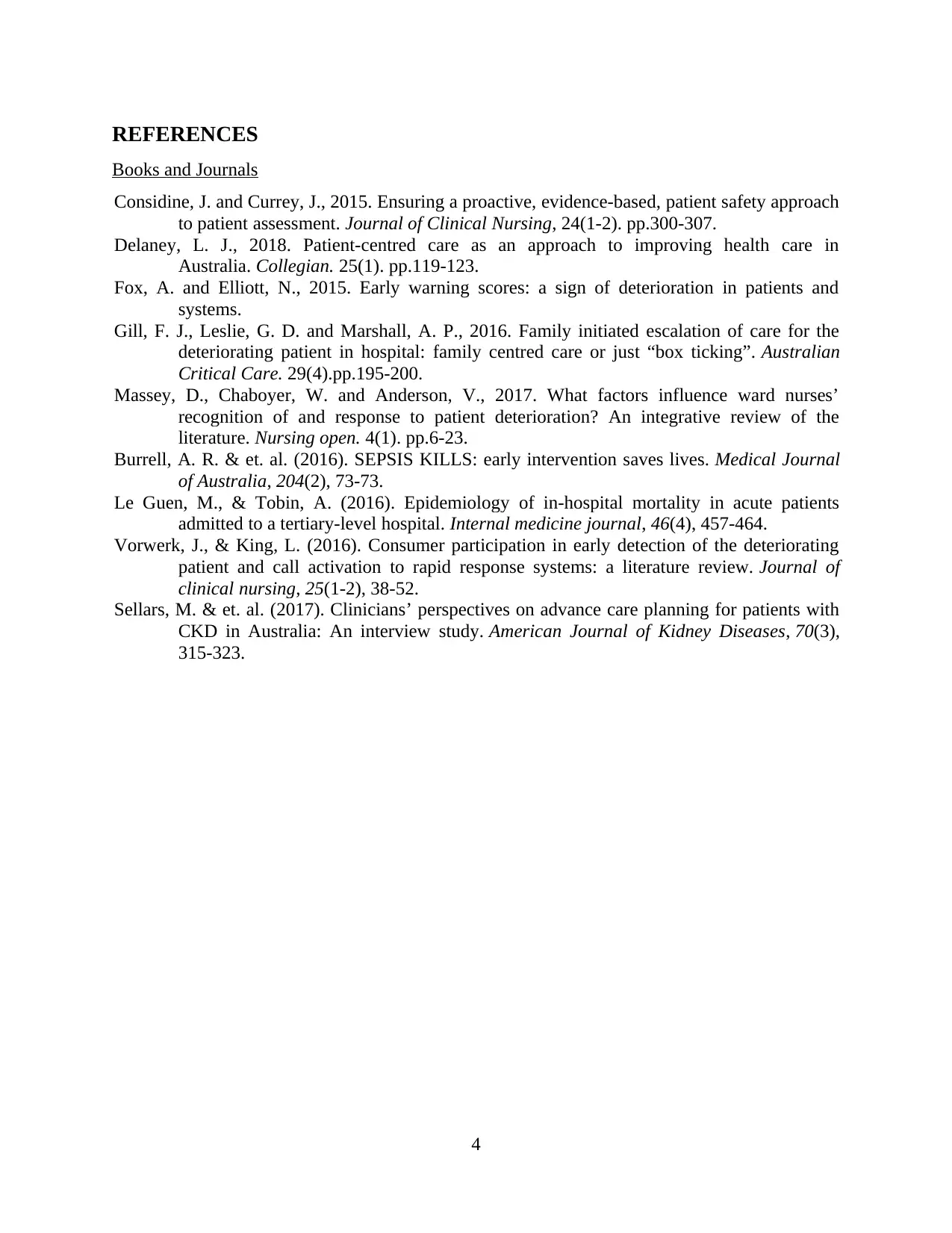
REFERENCES
Books and Journals
Considine, J. and Currey, J., 2015. Ensuring a proactive, evidence‐based, patient safety approach
to patient assessment. Journal of Clinical Nursing, 24(1-2). pp.300-307.
Delaney, L. J., 2018. Patient-centred care as an approach to improving health care in
Australia. Collegian. 25(1). pp.119-123.
Fox, A. and Elliott, N., 2015. Early warning scores: a sign of deterioration in patients and
systems.
Gill, F. J., Leslie, G. D. and Marshall, A. P., 2016. Family initiated escalation of care for the
deteriorating patient in hospital: family centred care or just “box ticking”. Australian
Critical Care. 29(4).pp.195-200.
Massey, D., Chaboyer, W. and Anderson, V., 2017. What factors influence ward nurses’
recognition of and response to patient deterioration? An integrative review of the
literature. Nursing open. 4(1). pp.6-23.
Burrell, A. R. & et. al. (2016). SEPSIS KILLS: early intervention saves lives. Medical Journal
of Australia, 204(2), 73-73.
Le Guen, M., & Tobin, A. (2016). Epidemiology of in‐hospital mortality in acute patients
admitted to a tertiary‐level hospital. Internal medicine journal, 46(4), 457-464.
Vorwerk, J., & King, L. (2016). Consumer participation in early detection of the deteriorating
patient and call activation to rapid response systems: a literature review. Journal of
clinical nursing, 25(1-2), 38-52.
Sellars, M. & et. al. (2017). Clinicians’ perspectives on advance care planning for patients with
CKD in Australia: An interview study. American Journal of Kidney Diseases, 70(3),
315-323.
4
Books and Journals
Considine, J. and Currey, J., 2015. Ensuring a proactive, evidence‐based, patient safety approach
to patient assessment. Journal of Clinical Nursing, 24(1-2). pp.300-307.
Delaney, L. J., 2018. Patient-centred care as an approach to improving health care in
Australia. Collegian. 25(1). pp.119-123.
Fox, A. and Elliott, N., 2015. Early warning scores: a sign of deterioration in patients and
systems.
Gill, F. J., Leslie, G. D. and Marshall, A. P., 2016. Family initiated escalation of care for the
deteriorating patient in hospital: family centred care or just “box ticking”. Australian
Critical Care. 29(4).pp.195-200.
Massey, D., Chaboyer, W. and Anderson, V., 2017. What factors influence ward nurses’
recognition of and response to patient deterioration? An integrative review of the
literature. Nursing open. 4(1). pp.6-23.
Burrell, A. R. & et. al. (2016). SEPSIS KILLS: early intervention saves lives. Medical Journal
of Australia, 204(2), 73-73.
Le Guen, M., & Tobin, A. (2016). Epidemiology of in‐hospital mortality in acute patients
admitted to a tertiary‐level hospital. Internal medicine journal, 46(4), 457-464.
Vorwerk, J., & King, L. (2016). Consumer participation in early detection of the deteriorating
patient and call activation to rapid response systems: a literature review. Journal of
clinical nursing, 25(1-2), 38-52.
Sellars, M. & et. al. (2017). Clinicians’ perspectives on advance care planning for patients with
CKD in Australia: An interview study. American Journal of Kidney Diseases, 70(3),
315-323.
4
⊘ This is a preview!⊘
Do you want full access?
Subscribe today to unlock all pages.

Trusted by 1+ million students worldwide

5
1 out of 7
Related Documents
Your All-in-One AI-Powered Toolkit for Academic Success.
+13062052269
info@desklib.com
Available 24*7 on WhatsApp / Email
![[object Object]](/_next/static/media/star-bottom.7253800d.svg)
Unlock your academic potential
Copyright © 2020–2025 A2Z Services. All Rights Reserved. Developed and managed by ZUCOL.





